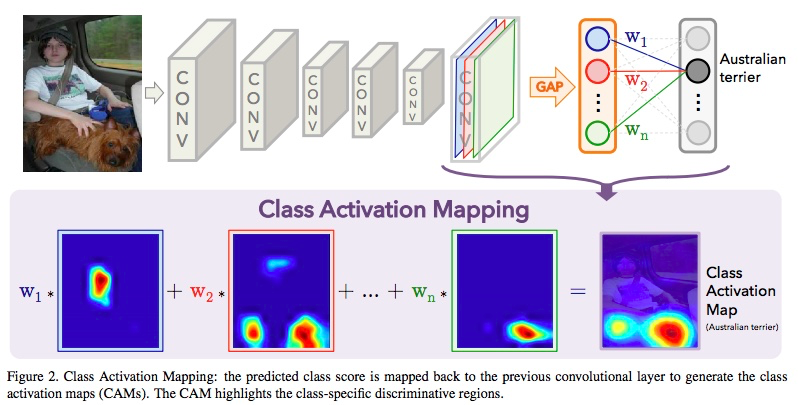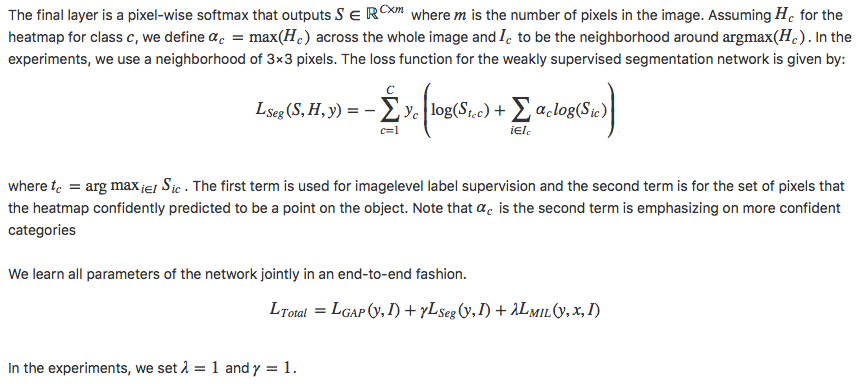[CVPR2017] Weakly Supervised Cascaded Convolutional Networks论文笔记
p.p1 { margin: 0.0px 0.0px 0.0px 0.0px; font: 14.0px "Helvetica Neue"; color: #042eee }
p.p2 { margin: 0.0px 0.0px 0.0px 0.0px; font: 14.0px "Helvetica Neue"; color: #323333 }
p.p3 { margin: 0.0px 0.0px 0.0px 0.0px; font: 16.0px "Helvetica Neue"; color: #323333 }
p.p4 { margin: 0.0px 0.0px 0.0px 0.0px; font: 14.0px "Helvetica Neue"; color: #323333; min-height: 16.0px }
p.p5 { margin: 0.0px 0.0px 0.0px 0.0px; font: 17.0px STIXGeneral; color: #323333 }
p.p6 { margin: 0.0px 0.0px 0.0px 0.0px; font: 12.0px STIXGeneral; color: #323333 }
p.p7 { margin: 0.0px 0.0px 0.0px 0.0px; font: 17.0px "Helvetica Neue"; color: #323333; min-height: 20.0px }
p.p8 { margin: 0.0px 0.0px 0.0px 0.0px; font: 17.0px STIXSizeOneSym; color: #323333 }
p.p9 { margin: 0.0px 0.0px 0.0px 0.0px; text-align: center; font: 17.0px STIXGeneral; color: #323333 }
p.p10 { margin: 0.0px 0.0px 0.0px 0.0px; text-align: center; font: 14.0px "Helvetica Neue"; color: #323333 }
p.p11 { margin: 0.0px 0.0px 0.0px 0.0px; font: 9.0px STIXGeneral; color: #323333 }
li.li2 { margin: 0.0px 0.0px 0.0px 0.0px; font: 14.0px "Helvetica Neue"; color: #323333 }
span.s1 { text-decoration: underline }
span.s2 { }
span.s3 { vertical-align: -0.5px }
span.s4 { vertical-align: -9.0px }
ul.ul1 { list-style-type: disc }
ul.ul2 { list-style-type: circle }
https://www.csee.umbc.edu/~hpirsiav/papers/cascade_cvpr17.pdf
Weakly Supervised Cascaded Convolutional Networks, Ali Diba, Vivek Sharma, Ali Pazandeh, Hamed Pirsiavash and Luc Van Gool
亮点
- 通过多任务叠加(分类,分割)提高了多物体弱监督检测的正确率
- 通过利用segmentation筛选纯净的proposals,得到了更鲁棒的结果
- 为弱监督分割任务设计比较鲁棒的loss
- 只考虑全局的分类结果和置信度对高的部分
- 通过loss的weights关注到最需要关注的部分
相关工作
One of the most common approaches [7] consists of the following steps:
- generates object proposals,
- extracts features from the proposals,
- applies multiple instance learning (MIL) to the features and finds the box labels from the weak bag (image) labels.
弱监督物体检测难点: 弱监督物体检测对初始化要求很高,不好的初始化可能会使网络陷入局部最优解,解决的办法主要有以下几个:
- improve the initialization [31, 9, 28, 29]
- regularizing the optimization strategies [4, 5, 7]
- [17] employ an iterative self-learning strategy to employ harder samples to a small set of initial samples
- [15] use a convex relaxation of soft-max loss
Majority of the previous works [25, 32] use a large collection of noisy object proposals to train their object detector. In contrast, our method only focuses on a very few clean collection of object proposals that are far more reliable, robust, computationally efficient, and gives better performance
方法
Two-stage: proposal and image classification (conv1 till con5, global pooling) + multiple instance learning (2fc, score layer)

1. image classification: CNN with global average pooling (GAP) [36]中引入,将分类过程中fc层的weights作为原来convolutional layer输出的权重并将所有频道加权得到的图作为class activation map。在这一步中,还产生一个分类的loss LGAP
[36] B. Zhou, A. Khosla, A. Lapedriza, A. Oliva, and A. Torralba. Learning deep features for discriminative localization. In CVPR, 2016. 3, 4, 5, 6, 7, 8

2. multiple instance learning
Proposal: edgeboxs [37] is used to generate an initial set of object proposals. Then we threshold the class activation map [36] to come up with a mask. Finally, we choose the initial boxes with largest overlap with the mask.

Three-stage: more information about the objects’ boundary learned in a segmentation task can lead to acquisition of a better appearance model and then better object localization.
- 主要思想:分割监督信号帮助提升定位准确率。
- 弱分割监督信号:上一级得到的mask


实验结果
PASCAL VOC 2007
- +3.3% classification compared with [18]
- +1.6% correct localization compared with [27]
- +0.6% compared with [6]
PASCAL VOC 2010
- +3.3% compared with [6]
PASCAL VOC 2012
- +8.8% compared with [18]
- ILSVRC 2013
- +5.5% compared with [18]
Object detection training
- PASCAL VOC 2007 test set: Faster RCNN trained by the pseudo ground-truth (GT) bounding boxes generated by our cascaded networks performs slightly better than our transfered model. (+0.3%)
[6] H. Bilen and A. Vedaldi. Weakly supervised deep detection networks. In CVPR, 2016. 6, 7, 8
[18] D. Li, J.-B. Huang, Y. Li, S. Wang, and M.-H. Yang. Weakly supervised object localization with progressive domain adaptation. In IEEE Conference on Computer Vision and Pattern Recognition, 2016. 2, 6, 7
[27] K. Simonyan and A. Zisserman. Very deep convolutional networks for large-scale image recognition. In ICLR, 2015. 5, 6
p.p1 { margin: 0.0px 0.0px 0.0px 0.0px; font: 16.0px "Helvetica Neue"; color: #323333 }
p.p2 { margin: 0.0px 0.0px 0.0px 0.0px; font: 14.0px "Helvetica Neue"; color: #323333 }
li.li2 { margin: 0.0px 0.0px 0.0px 0.0px; font: 14.0px "Helvetica Neue"; color: #323333 }
span.s1 { }
ul.ul1 { list-style-type: disc }
ul.ul2 { list-style-type: circle }
p.p1 { margin: 0.0px 0.0px 0.0px 0.0px; font: 14.0px "Helvetica Neue"; color: #042eee }
p.p2 { margin: 0.0px 0.0px 0.0px 0.0px; font: 14.0px "Helvetica Neue"; color: #323333 }
p.p3 { margin: 0.0px 0.0px 0.0px 0.0px; font: 16.0px "Helvetica Neue"; color: #323333 }
p.p4 { margin: 0.0px 0.0px 0.0px 0.0px; font: 14.0px "Helvetica Neue"; color: #323333; min-height: 16.0px }
p.p5 { margin: 0.0px 0.0px 0.0px 0.0px; font: 17.0px STIXGeneral; color: #323333 }
p.p6 { margin: 0.0px 0.0px 0.0px 0.0px; font: 12.0px STIXGeneral; color: #323333 }
p.p7 { margin: 0.0px 0.0px 0.0px 0.0px; font: 17.0px "Helvetica Neue"; color: #323333; min-height: 20.0px }
p.p8 { margin: 0.0px 0.0px 0.0px 0.0px; font: 17.0px STIXSizeOneSym; color: #323333 }
p.p9 { margin: 0.0px 0.0px 0.0px 0.0px; text-align: center; font: 17.0px STIXGeneral; color: #323333 }
p.p10 { margin: 0.0px 0.0px 0.0px 0.0px; text-align: center; font: 14.0px "Helvetica Neue"; color: #323333 }
p.p11 { margin: 0.0px 0.0px 0.0px 0.0px; font: 9.0px STIXGeneral; color: #323333 }
li.li2 { margin: 0.0px 0.0px 0.0px 0.0px; font: 14.0px "Helvetica Neue"; color: #323333 }
span.s1 { text-decoration: underline }
span.s2 { }
span.s3 { vertical-align: -0.5px }
span.s4 { vertical-align: -9.0px }
ul.ul1 { list-style-type: disc }
ul.ul2 { list-style-type: circle }
[CVPR2017] Weakly Supervised Cascaded Convolutional Networks论文笔记的更多相关文章
- [CVPR 2016] Weakly Supervised Deep Detection Networks论文笔记
p.p1 { margin: 0.0px 0.0px 0.0px 0.0px; font: 13.0px "Helvetica Neue"; color: #323333 } p. ...
- [论文阅读] Joint Face Detection and Alignment using Multi-task Cascaded Convolutional Networks(MTCNN)
相关论文:Joint Face Detection and Alignment using Multi-task Cascaded Convolutional Networks 概论 用于人脸检测和对 ...
- Visualizing and Understanding Convolutional Networks论文复现笔记
目录 Visualizing and Understanding Convolutional Networks 论文复现笔记 Abstract Introduction Approach Visual ...
- 《Joint Face Detection and Alignment using Multi-task Cascaded Convolutional Networks》
<Joint Face Detection and Alignment using Multi-task Cascaded Convolutional Networks> 论文主要的三个贡 ...
- Densely Connected Convolutional Networks 论文阅读
毕设终于告一段落,传统方法的视觉做得我整个人都很奔溃,终于结束,可以看些搁置很久的一些论文了,嘤嘤嘤 Densely Connected Convolutional Networks 其实很早就出来了 ...
- 【Semantic Segmentation】 Instance-sensitive Fully Convolutional Networks论文解析(转)
这篇文章比较简单,但还是不想写overview,转自: https://blog.csdn.net/zimenglan_sysu/article/details/52451098 另外,读这篇pape ...
- 【Detection】R-FCN: Object Detection via Region-based Fully Convolutional Networks论文分析
目录 0. Paper link 1. Overview 2. position-sensitive score maps 2.1 Background 2.2 position-sensitive ...
- [CVPR2015] Is object localization for free? – Weakly-supervised learning with convolutional neural networks论文笔记
p.p1 { margin: 0.0px 0.0px 0.0px 0.0px; font: 13.0px "Helvetica Neue"; color: #323333 } p. ...
- Bag of Tricks for Image Classification with Convolutional Neural Networks论文笔记
一.高效的训练 1.Large-batch training 使用大的batch size可能会减小训练过程(收敛的慢?我之前训练的时候挺喜欢用较大的batch size),即在相同的迭代次数 ...
随机推荐
- Ubuntu快速截图
以前截图,都是按Print键全屏截图,Alt+Print可以截当前的窗口.同时把系统自带的截图工具放到面板上,用的时候点击一下,再选择区域截图,很是不方便.不过,Ubuntu允许自己定义快捷键.要自己 ...
- OpenCV进行图像相似度对比的几种办法
转载请注明出处:http://blog.csdn.net/wangyaninglm/article/details/43853435, 来自:shiter编写程序的艺术 对计算图像相似度的方法,本文做 ...
- 队列链式存储 - 设计与实现 - API函数
队列相关基础内容参我的博文:队列顺序存储 - 设计与实现 - API函数 队列也是一种特殊的线性表:可以用线性表链式存储来模拟队列的链式存储. 主要代码: // linkqueue.h // 队列链式 ...
- OBJ-C中dispatch_once的用法
见如下代码: +(GameState*)sharedGameState{ static GameState *sharedInstance; static dispatch_once_t onceTo ...
- 色彩转换——RGB & HSL
RGB to HSL The R,G,B values are divided by 255 to change the range from 0..255 to 0..1: R' = R/255 G ...
- 苹果新的编程语言 Swift 语言进阶(八)--属性
属性是特定类.结构或枚举的相关值,属性根据作用域不同分为实例属性与类型属性,还可以根据是否存储分为存储属性和计算属性. 1.1 实例属性 为一个类.结构或枚举定义的属性默认属于实例属性,即该属性属于为 ...
- Java中如何封装自己的类,建立并使用自己的类库?
from:http://blog.csdn.net/luoweifu/article/details/7281494 随着自己的编程经历的积累会发现往往自己在一些项目中写的类在别的项目中也会有多次用到 ...
- C语言实现printf的基本格式输出%d,%c,%p,%s
关于printf的实现,想必看过我之前发表的文章的伙伴们已经了解了不少基本的知识.好了,接下来不多说了,直接上源码,看看一种简单的实现方式: #include <stdio.h> #def ...
- 使用schemaExport自动生成表结构
一.Hibernate原生状态 ? 1 2 3 4 5 Configuration cfg = new Configuration().configure(); SchemaExport expo ...
- sieve的objective-c实现
用obj-cl来实现前面的sieve代码貌似"丑"了不少,应该有更好的方式:比如不用Foundation或不用NSArray类,而改用其它更"底层"的类. 先把 ...
